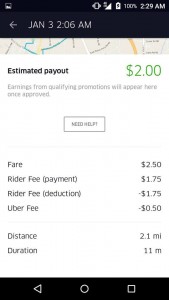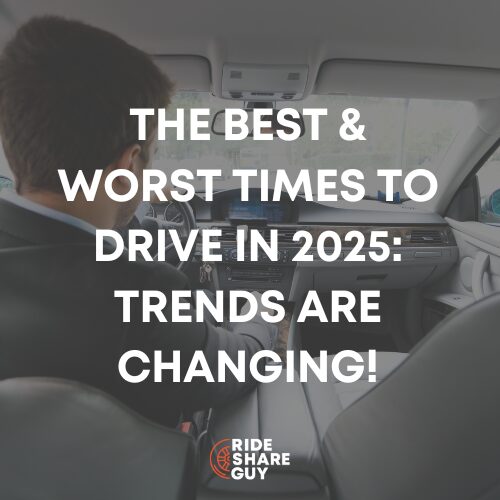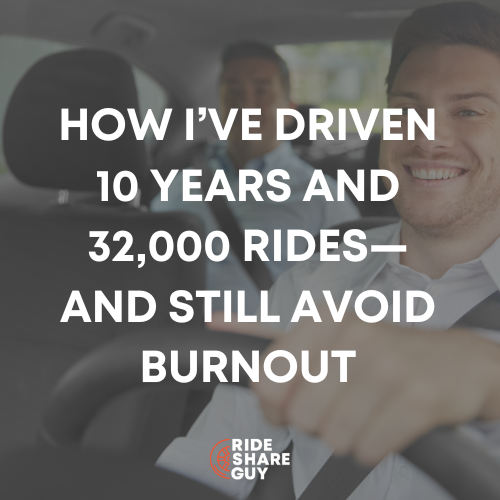Harry here. Driving in big cities like SF and LA present very different challenges than in smaller markets like Atlanta or Detroit. But regardless of where you live, there are always things you could be doing to make it work and think outside the box.
Today, RSG contributor Jon Knope examines what it’s like to drive in one of those tough markets. Jon hails from Atlanta, which offers just a $0.75 per mile rate, and today he shares some tips on everything he’s doing to make it work.

Uber’s latest rate cut has left many drivers shocked and dismayed at both its severity and its timing. I drive in Atlanta, where the decision comes not only during the usual winter slump, but also hot on the heels of a vastly unpopular UberPool rollout.
To add insult to injury, the competition for riders is still as fierce as ever: pings are often few and far between. Many drivers are asking themselves if driving for Uber is worth it anymore. Is it still possible to turn a profit in a bad market?
For those willing to metaphorically “go the extra mile,” it can be – but there’s a lot more to making money with rideshare than just finding lots of passengers. Here are my top 5 tips for staying profitable, even when your market takes a turn for the worse.
1. Know when to drive – and when not to

Between gas, oil changes, brakes, tires, and repairs, you don’t need me to tell you that putting miles on your car is the same as taking dollars out of your wallet. Thus, it’s of utmost importance that you always drive with an eye towards your bottom line.
The best thing you can do in a bad market is to minimize the distance you drive between pickups. Always be on the lookout for high-traffic areas near your rider’s destination. When you get there, stop and wait for your next ping – basically try to minimize extraneous driving.
Bring a book if you have to (I try to wait at least 30 minutes or so before relocating) and be sure to check the passenger app regularly to position yourself at least a hundred feet away from any competing drivers who might be snagging pings out from under you. If your acceptance rate permits, consider declining low-paying UberPool requests (aka peeing in the pool).
If your city enjoys its nightlife, you might notice brief surges around closing time. When working the bars, carefully monitor any surge pricing from week to week. If the surge kicks in consistently right after closing, you may find that it’s more profitable to wait offline until then to maximize your earnings. You don’t want to get stuck earning a cheap fare while a few miles behind you, a 2.0+ surge fades into the sunset (or sunrise, as the case may be).
The flip-side of this is that in most markets (especially ones with lots of drivers) it’s best to avoid chasing after surges. In Atlanta, I see many new drivers start their engines and race towards every surge that pops up on the map. This is inadvisable for two reasons: First, more often than not, the surge is gone before you even make it to the area. Second, once the surge is gone, you’re left in an area upon which half the drivers in the city have just descended, making snagging a ride more difficult – and forcing you to drive yet more unpaid miles to a less competitive area.
How many riders you’ll get in a given outing is a function of two things: how many requests are coming in on the platform, and how many drivers are available to accept them. Lots of drivers only consider the first part of this equation. Try driving at different times to see when the fewest drivers are available. Often there are lots of long airport runs to be had between 4 and 7AM, when many drivers are asleep. Find out the best times to drive in your market – then focus on those. Remember, time is money – and so are those miles.
2. Consider your car
If rates in your city are bottoming out, the last thing you want is an inefficient rideshare vehicle. It’s important to realize that the cost of driving different vehicles varies widely. If you’re driving a gas-guzzler or spending lots of money on repairs, it’s almost impossible to stay profitable driving an UberX in a bad market.
For example, an ‘07 Chevy Suburban with tons of miles on the odometer will eat up UberX profits much faster than, say, a Prius that’s still under warranty. In a tough market, there’s less wiggle room. If you have the option: buy a used hybrid – or at least a more efficient car.
Related Article: Why A Brand New Prius Isn’t Always the Answer
My tiny (non-hybrid) Mitsubishi Mirage retails for well under $14k, and its three-cylinder engine gets anywhere from 30 to 45 miles per gallon. Unlike my previous car, it also runs on regular grade gas. After the upgrade, the cost of my fill ups went down by more than half. I was able to save that money for ongoing maintenance and unexpected repairs.
As with any business, always budget for expenses. I use SherpaShare to keep track of my mileage and fuel costs. (This comes in handy at tax time, too!)
3. Cash in on recruitment
You’re probably already aware that Uber and Lyft pay recruitment bonuses for signing up new passengers. This not only helps you, but it also helps everyone in your market by creating more business. Many drivers create business cards (using VistaPrint or a similar service) with their referral codes and information for prospects about the benefits they’ll receive when they sign up – usually a discount on their first trip.
Once you have your cards, take them with you everywhere, and pass them out in person at any events you might come across: concerts, festivals, conventions, etc. After handing out your cards, stick around to snag any resulting fares. You can even ask local businesses like hotels and conference centers to keep a stack of your referral cards in their lobby or welcome area.
Related Podcast: The Ultimate Passenger Referral Strategy
Although it does require a bit of extra effort (and cash) to print and distribute cards, this method is ideal because it helps cut down on your biggest expense – namely, driving – and can help keep your income stream moving even when you’re not on the road. I’ve seen several posts from Atlanta drivers boasting earnings of over $500 a week despite logging 0 hours “online.” Obviously, getting to that point takes a lot of time, effort, and practice – but it’s often more profitable than sitting around endlessly waiting for $2 and $3 fares.
Other drivers have found good profits in recruiting and mentoring new drivers. Here in Atlanta, some drivers have taken to setting up Uber “job fairs,” coordinating with shopping centers and other establishments to set up an information table with referral codes and city-specific tips to help new drivers get started.
They also use banners and tablecloths with the Uber logo to attract attention, and some even print and pass out informational brochures. You can even take this a step further by making yourself available for mentoring to help keep your new recruits on the road. Although this definitely won’t help any over-saturation issues in your city, it can be very beneficial to your own bottom line.
4. Network
One of the most valuable aspects of your position as a rideshare driver is your ability to mingle with all types of people. If you have a skill, hobby, or interest that could be translated into a job, try to share your enthusiasm with every passenger. You never know who might be friends with the hiring manager at a great local company. If you’re well-spoken and knowledgeable, your driving work just might land you your next career.
If you’re still looking for your calling, try taking some online courses to see what interests you. In our digital age, you can learn just about any skill for cheap, or even free. Build up a portfolio by completing volunteer projects in your field. If you’re a Web designer, for example, start by designing a website for a charity organization. You’d be surprised where a few good work samples can take you!
Some networking tips: always carry business cards – even a plain card with your name and contact info will do. Pass them out whenever appropriate, but don’t be too pushy. Consider keeping a conversation starter in your car that will get people asking the right questions. For instance, if you’re interested in finding a position in the sports industry, you might consider hanging a baseball card from your rearview, or mounting a decorative hockey puck on your dash. Unique décor like this always gets passengers curious, and gives you plenty of opportunities to share your passion. It can be discouraging if your efforts don’t pay off right away, but be patient. Remember that when it comes down to it, networking is just a numbers game!
Note from Harry: I carry premium custom business cards and whenever I pass them out, people always say, “cool cards!” It’s a great way to quickly stand out.
5. Diversify
If you’ve tried all this and the rideshare industry still isn’t making it happen for you, consider other types of work you can do with your car. This will vary by city, but most areas have at least one other option. Many drivers already work for Lyft and Uber simultaneously; I even run them from the same phone.
Related Article: How To Drive For Lyft and Uber At The Same Time
If you’re willing to branch out even more, I strongly recommend adding delivery to your repertoire. Many food delivery services pay about the same as (and in some cases, much more than) Uber or Lyft – and they offer more consistency, especially in the cold winter months (when no one wants to leave the house!)
DoorDash is a fan favorite: I work for them here in Atlanta anywhere from 10-20 hours every week. Other big names in food delivery include Postmates, GrubHub, Caviar, and Favor. Amazon is also in the process of starting their own flexible delivery program in several cities, and they’re currently paying $18 per hour to deliver packages from their warehouses.
If you’re willing to do some grocery shopping, companies like Instacart and Shipt are usually hiring too. Signing up for these companies is similar to signing up for Uber, and it’s super convenient. You may lose a little flexibility (for instance, DoorDash requires you to set your own schedule in advance) but often the consistent business and relatively hassle-free driving experience make for good additions to your work week.
Many private courier companies also hire workers to deliver packages and documents in their own cars. The major players here on the east coast are Courier Express, Dynamex and Lasership. In California, it’s OnTrac.
And if you’re more geared towards small business, you can often find positions as an in-house delivery driver for local restaurants. A quick review of job posting sites like Indeed.com or Craigslist will reveal delivery opportunities with other types of businesses. Even the healthcare industry needs drivers: here in Atlanta, companies like WellStar and Emory Healthcare are always looking for people with cars to transport medical supplies between facilities.
Unlike Uber and Lyft, more traditional delivery outfits may require a large vehicle or commitment to a set schedule. However, you’ll also be compensated accordingly.
Bonus Tips
Another way you can diversify is by privatizing your existing rideshare business. If you work regular areas and times, try to develop relationships with anyone who might be in need of a regular driver. Consider “specialty” clients like elderly folks traveling to and from appointments, or working with parents to facilitate their kids’ school pickups and drop-offs.
Related Podcast – RSG024: Taking Your Rideshare Game To The Next Level With Bradley Zane
It can take a while to find these types of opportunities, and ideally you’ll need to make sure you’re legally equipped to handle the resulting income – perhaps by creating your own LLC. But if you can pull this off, you can make much more by avoiding Uber’s fees.
For more information on maximizing your rideshare profits, consider checking out Harry’s online course, which takes an in-depth look at these techniques and many more. I know as well as anyone that driving can be a tough business if your rates suddenly take a nosedive. Work smart and think outside the box to ensure you won’t just drive – you’ll thrive.
Did we miss a good tip for making money in a bad market? Help a driver out and let us know in the comments! Thanks for reading, and hang in there.
– Jon @RSG





